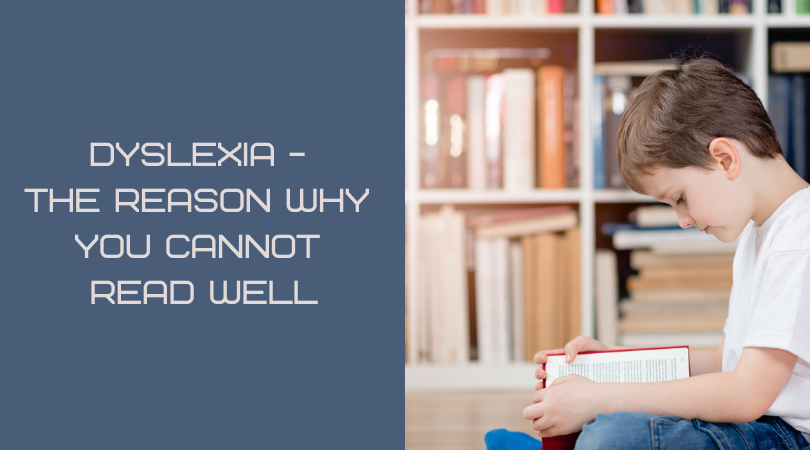 The problem of impossibility to read may be explained not only poor environment but also medical conditions. Dyslexia is one of the most common learning problems in children, which manifests itself as a specific reading disorder. The cause of this disease is associated with neurological disorders of a genetic nature. A dyslexic person has difficulty learning how to read and write.
The problem of impossibility to read may be explained not only poor environment but also medical conditions. Dyslexia is one of the most common learning problems in children, which manifests itself as a specific reading disorder. The cause of this disease is associated with neurological disorders of a genetic nature. A dyslexic person has difficulty learning how to read and write.
When reading, a dyslexic child constantly faces difficulties: even one word that he does not know (does not have its image) destroys the general image of what he read, that is, the text becomes completely incomprehensible to the child. Very often people have impairments not only in the ability to read (dyslexia), but also in the ability to write correctly (dysgraphia).
There are many people facing such a problem and trying to find how to overcome it. They visit healthcare specialists, surf Trust Pharmacy and drugstores to find a medicine able to improve their state. But let’s consider the causes, possible diagnosis and treatment of Dyslexia.
Based on numerous studies, it has been determined that neurobiological causes are the basis of dyslexia. In this case, certain parts of the brain have less functionality (in particular, we are talking about the posterior part of the middle left temporal gyrus). There are also certain differences in the structure of brain tissue. At the same time, as it turned out, dyslexia is a hereditary disease, which is also confirmed by the genes found in the course of research, which are responsible for its occurrence.
In oral speech, children with dyslexia have defects in sound pronunciation, poor vocabulary, inaccurate understanding and use of words. The speech of children with dyslexia is characterized by incorrect grammatical design, the absence of detailed sentences, and incoherence.
In case of phonemic dyslexia, substitutions and mixing among themselves of sounds that are similar in articulatory or acoustic characteristics come to the fore. In other cases, letter-by-letter reading, distortions of the sound-syllable structure of the word (additions, omissions, permutations of sounds and syllables) are noted.
Semantic dyslexia is also called “mechanical reading”, because with this form, comprehension of the read word, phrase, text is impaired with the correct reading technique. Violation of reading comprehension can occur in both syllable and synthetic reading.
In the case of agrammatic dyslexia, there is an incorrect reading of the case endings of nouns and adjectives, forms and tenses of verbs, a violation of the agreement of parts of speech in number, gender and case, etc. Agrammatisms when reading correspond to those in oral speech and writing.
With mnestic dyslexia, the association between the visual form of the letter, and its pronunciation and acoustic image is disrupted. That is, the child does not remember the letters, which is manifested in their mixing and substitutions when reading. Examination of auditory-speech memory in a child with mnestic dyslexia reveals the impossibility of reproducing a series of 3-5 sounds or words, a violation of the order of their sequence, a reduction in the number, elision.
Dyslexia in children is assessed for reading, hearing, language development, and cognitive ability. Also, children undergo a psychological examination, with the help of which the functional characteristics of children and their preferred forms of education are determined. At the request of a teacher or parent, research is carried out that will help determine the level of text comprehension when reading, text analysis, understanding of speech being read, listening speech. Through this research, effective approaches can be identified for teaching a child.
As a result of the study, the functions of active and passive speech are assessed, and cognitive abilities (memory, justification, attention) are examined. Language, pronunciation, speech perception are also assessed.
Psychological evaluation helps to identify emotional aspects that exacerbate reading disorder. For this, a complete family history is collected, which includes the presence of emotional disturbances and mental disorders in the family.
Dysgraphia and dyslexia, despite their prevalence, should be corrected only by a qualified speech therapist. Correction can take several months or even years, and individual children will never be able to overcome this ailment.
Dyslexia correction methods depend on its causes. So, for example, reading problems can be associated with poor eyesight of the child, and he cannot read the text; also problems can be caused by the child’s mental retardation (although many dyslexias do not have any developmental disabilities). When correcting dyslexia in these cases, elimination and correction of the root cause is required, and only then – the solution of problems with reading texts.
Researchers have found that dyslexia is mainly associated with malfunctioning of certain parts of the brain. We can say that dyslexia is often a hereditary disorder: if the child’s family has already had problems with reading or writing, as well as other neuro- and psychophysiological problems, then there is a likelihood of problems in children.
Category: General
Tags: children, Dyslexia